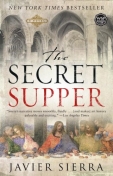BKMT READING GUIDES
The Secret Supper: A Novel
by Javier Sierra
Paperback : 368 pages
0 club reading this now
0 members have read this book
Introduction
(Milan, 1497: Leonardo da Vinci is completing his masterpiece, The Last Supper. Pope Alexander VI is determined to execute him after realizing that the painting contains clues to a baffling -- and blasphemous -- message, which he is determined to decode. The Holy Grail and the Eucharistic Bread are missing, there is no meat on the table and, shockingly, the apostles are portraits of well-known heretics -- none of them depicted with halos. And why has the artist painted himself into the scene with his back turned toward Jesus? The clues to Leonardo's greatest puzzle are right before your eyes....
The Da Vinci juggernaut rolls on, this time in the capable hands of a bestselling author in the Spanish-speaking world. The Secret Supper has been ably translated by Alberto Manguel, author of A History of Reading, that delightful revelation that squiggles on a page are words, and words make stories. Set in 1497 Milan, at the time of the painting of the Cenacolo, or The Last Supper, in the refectory of Santa Maria delle Grazie, Sierra has created a tale of religious fanaticism, betrayal, murder, Church politics, artistic chicanery and mystery to confound the reader.
Fra Agostino Leyre, a Papal Inquisitor, is sent to Milan to confirm--or not--the messages of the "Soothsayer," who alleges that Leonardo Da Vinci is a heretic and has hidden heretical messages in his painting of The Last Supper. Leonardo is a figure larger than life, literally. A blue-eyed, tall, handsome man, always dressed in white, he is surrounded by faithful students and friends who are his acolytes. His brilliant mind, ranging over a multitude of ideas, has gained him a reputation for "hiding heterodox ideas in paintings apparently pious."
What Father Agostino follows is a labyrinthine path through alliances and rivalries, differences of opinion about Leonardo and a discussion of the heresy of the Cathars. They are a fascinating sect, more extra-Christianity than Christian heretics. Their practices are based on a belief that certain deprivations--primarily food and sex--will purify and make them worthy. Sierra is a very fine guide, taking the reader through palaces and monasteries rife with intrigue and typical of the flowering of intellect that came after the Dark Ages. It is a time when "Suddenly, from one day to the next, Plato's Greece, Cleopatra's Egypt and even the extravagant curiosities of the Chinese Empire that Marco Polo discovered seemed to deserve greater praise than our own Scriptural stories." Dangerous for the incumbency.
A compelling case is made that Leonardo's heretical beliefs are there for all to see in The Last Supper, if only we know how to find them. Sierra gives us the key--and keeps the suspense going right up to the end of the book. It isn't necessary to believe any of it, or even care if it's true, to enjoy this pilgrimage through another time and place. --Valerie Ryan
Discussion Questions
No discussion questions at this time.Book Club Recommendations
Recommended to book clubs by 0 of 0 members.
Book Club HQ to over 90,000+ book clubs and ready to welcome yours.
Get free weekly updates on top club picks, book giveaways, author events and more








